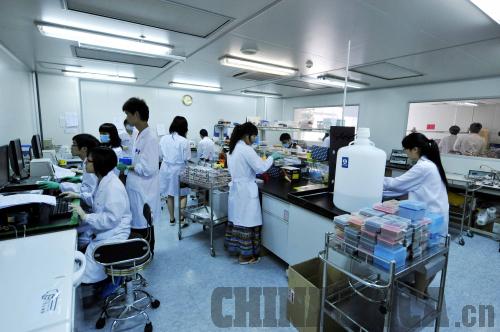|
 |
|
PROBE TACTICS: Researchers work at the Shenzhen Branch of the BGI. The BGI has made great contribution to the development of human genome sequence mapping CHEN YEHUA |
On April 14, 2003, scientists from China, the United States, Japan, Germany, France and Britain announced they had completed sequence mapping of the human genome, marking the end of the Human Genome Project (HGP) started in 1990. Yang Huanming, an academician from the Chinese Academy of Sciences (CAS) and Chairman of the Shenzhen branch of the Beijing Genomics Institute (BGI), led the group of Chinese experts that contributed to the project. The Chinese team played an integral part in the research until August 26, 2001.
Although each individual's genome consists of 23 pairs of chromosome and about 3 billion DNA base-pairs, differences between maps are common, providing clear evidence of polymorphism in humans.
Polymorphism refers to genetic differences between people. In fact, 99 percent of human genes are shared by everyone. However, the 1 percent of genes that vary from person to person make an enormous difference, causing varied disease susceptibility and different reactions to medicines.
DNA, which carries genetic information, determines one's height, skin color, etc. A genome is all of an organism's genes. Human beings have only one genome, which consists of 50,000 to 100,000 genes.
"In order to unravel the mystery of life and heredity, we need to start by sequencing genes and working out their functions," Yang said.
The HGP investigated genes via sequencing, locating them on the chromosomes and figuring out the function of proteins produced by each, enabling scientists to discover how human beings function at the molecular level.
However, the completed map of the human genome sequence has fallen short of Yang's expectations.
"Scientists generally think there is only a 0.1-percent difference in genes between any two people," Yang said. "However, we recently discovered more than 10 million gene variants, among which 8 million were previously unknown."
With the help of gene maps, doctors can now prevent and cure diseases by spotting gene variations. Genetic mapping has also laid a foundation for combating fatal diseases such as cancer and HIV/AIDS. Yang said that researchers from around the world will soon finish the sequencing and analysis of the genomes of 100,000 people.
"We have discovered an anti-HIV gene in Caucasians," Yang said. This is only one result of the 1,000 Genomes Project, launched on May 10, 2008, by the Shenzhen branch of the BGI, the Wellcome Trust Sanger Institute in Cambridge and the National Human Genome Research Institute in the United States. Two years later, Nature magazine published a cover story celebrating the great achievements of the project.
Scientists all agree that cancer is a genetic problem. Among the approximately 100,000 genes in each human cell, a proto-oncogene puts an individual at risk of developing the illness, while certain other genes can prevent it. A good genetics can promise health, but when carcinogenic factors cause a proto-oncogene to turn into an oncogene or when the vitality of a tumor-suppressing gene is weakened or lost, cancer becomes inevitable.
Scientists say human health is further determined by the genetic qualities of the bacteria and fungi that reside in human bodies.
China has contributed a great deal to the advancement of genomics research, taking a 1-percent research stake in the HGP.
Yang and his fellow scientists recently completed sequencing the genomes of several livestock and plant species, entering the world's top echelon of research. "Genomics have transformed people's conceptions of life and of themselves within the span of only a few years, making a considerable contribution to progressive research methods," he noted. CA
Tech Bytes
» A farmer in Kenya recently invented a device that battles aflatoxin contamination in corn. Aflatoxin is a fungi-produced chemical compound that is toxic to humans and has caused hundreds of deaths in Kenya. The invention is a simple tubular device that reduces the temperature and humidity of corn after it is packaged, making the conditions less viable for breeding bacteria. |